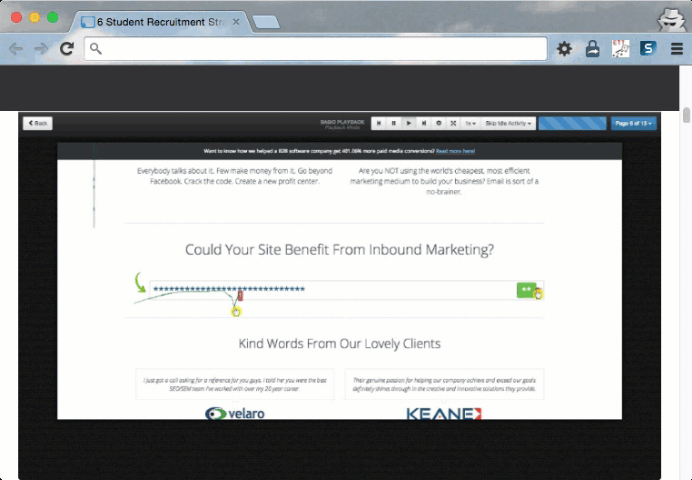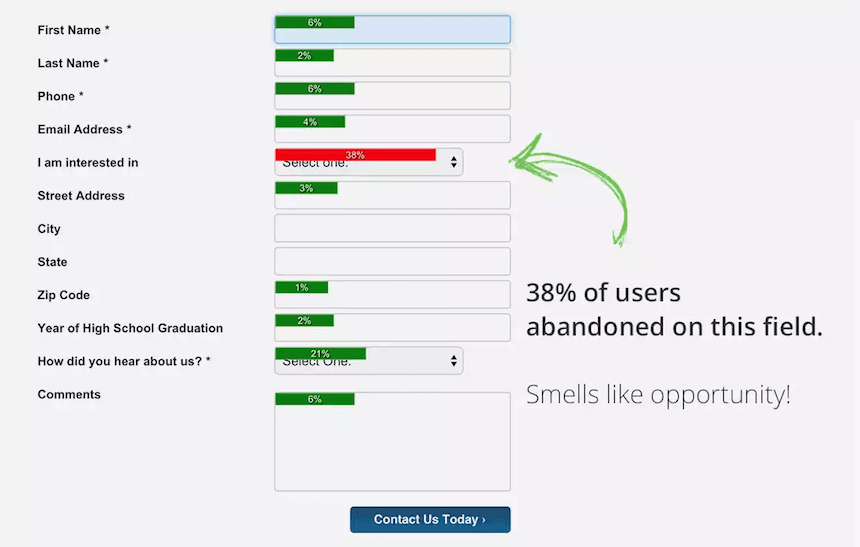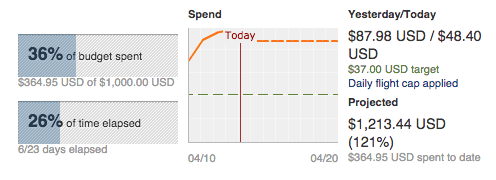
6 Digital marketing strategies for student recruitment
If you’re responsible for some or all of your school’s online student recruitment marketing, then I probably don’t need to remind you how complex student recruitment strategies for higher education institutions can be. Integrating your offline and online marketing plan is a neverending effort and there is always room for improvement.
But what kind of recruitment techniques can web professionals bring to the table on their own accord?
Below are six ways a university can form a marketing strategy for student recruitment that boosts student enrollment.
Strategy 1: Spy On Your Ideal Prospect

Analytics platforms offer you an abundance of information about website usage, but they often struggle to convey the full picture to your team — numbers, graphs, and tables can only communicate so much to the typical user. People, after all, prefer individualized stories to aggregated data. Just ask Don Draper from Mad Men.
How can you easily find compelling website usage stories that indicate larger trends in your digital marketing student recruitment strategy? Enter visitor session recording!
With visitor session recording, you can follow all the clicks, scrolls, and idleness of users on your site. Set up rule based tagging and you’ll be able to watch your ideal applicant’s web journey unfold before your very eyes. Mountains of data get broken down into smaller stories about individual visitors. From there, you can quickly infer what worked for the best visitors and what didn’t.
Visitor session recordings can be used to observe more than just ideal visitors. You can also look over the shoulder of your most frustrating site visitors — the ones who came so close to filling out a form before abandoning. These stories, perhaps, are even more indicative of what you need to change.
There are various services that allow you to access session recording after set up, like Hotjar.
Strategy 2: Fix Your Forms

Website forms are where most higher ed student recruitment strategies lead prospects. From these forms, a flurry of activity is set in motion as the student is led through your enrollment funnel.
But what can you do when you suspect your forms are discouraging prospective students from entering the enrollment funnel? The answer: use form analytics.
Form analytics provide you with a clear picture of what fields are giving users the most trouble. It aggregates data for all users who interacted with a form (i.e. anyone who clicked on one of the fields). From that data, you can see things like:
- How many prospects who interacted with your form actually completed it
- Which field users spent the most time on
- Which field most often preceded a prospect’s decision to abandon the form/your website
- Which field or fields are most often left blank
With easy-to-interpret data like that at your disposal, it makes form optimization easy. And you know already know how important your forms are for your student recruitment strategies.
Strategy 3: Pay For Promotion

Paid media is the most straightforward way to give your school’s student recruitment efforts a boost; it’s readily quantifiable and the impact is almost immediate.
In theory, a paid advertising makes sense for any institution: you pay $10,000 and the advertisements earn you $20,000 in new enrollments. In reality, however, there are plenty of problems that trip up higher education institutions’ marketing plans.
We could spend the whole blog post analyzing potential opportunities and problems with paid media for higher ed. Instead, we’ll simply touch on the most immediate issue: how to choose the right advertising network for student recruitment.
Default To The Ad Network
There are countless different advertising networks to choose from, but there’s none quite as big as Google for search or display ads. Google Search is the most visited web property in the United States and is used in 3/4s of all web searches. Add to this their display network plus partners, and you can get in front of just about any prospect you can dream of with Google ads.
Creating an effective, efficient ad campaign isn’t easy, however. It requires plenty of strategic planning, continuous management, and more. These advertising activities can all be carried out by a higher web professional that has the time and resources needed to learn, but there’s also plenty of agencies that can help you with this. That’s why I suggest retargeting campaigns for higher ed professionals just getting started with online ads for student recruiting.
A retargeting campaign is a campaign that advertises to prospects who already visited your website. Because these campaigns are so narrowly-focused, they’re a low-cost, easy-to-implement, and often feature high conversion rates. You can use this low-risk advertising option to start driving inquiries, applications, and other conversions for specific marketing objectives — like for your international student recruitment marketing plan and graduate program enrollment.
Use Social Ad Networks
Perhaps even more important to your school’s advertising efforts are social networks. These networks are where most of your prospects spend much of their leisure time, after all. Plus, the targeting options available on most networks are perfect for higher ed advertising campaigns.
Again, I’m going to suggest setting up some remarketing campaigns for higher education institutions that are just starting a digital ad initiative. But even if you’re not new to the game, you should strongly consider adding Twitter and Facebook retargeting to your marketing plan.
Social networks are also a good choice if you have specific student recruitment goals and objectives in mind. A LinkedIn sponsored update campaign, for example, is an excellent way to give your graduate student recruitment plan a boost. International students are another example segment that social networks like LinkedIn allow you to easily target.
Explore Other Ad Networks
There are plenty of other options available to schools outside of Google and social network ads. Advertising trends show a shift towards networks that rely on automated data aggregation to enable programmatic ad buying. An example of one vendor doing this is DataXu.
What is programmatic ad buying? Simply put, it’s a way for your school to place ads based on the individual’s browser history. For example, data aggregators can compile an audience of individuals “in-market” for education. That means, the audience you’re advertising to all share common characteristics of somebody in the market for something education-related (e.g. they visited a college information aggregator in the past 7 days).
The digital recruitment options available to higher education is more robust than ever before. As students continue to shift their attention to digital spaces, it’d serve your institution well to show up in the right places.
Strategy 4: Harvest Social Media Insights

You already know how important social networks are for prospective and incoming students. Now, it’s time to take that knowledge and use it to extract actionable insight for your recruitment plan.
Note first, that there are two sides to each one of your social interactions — what happens on the network and what happens on your website. Offline impact is another aspect of this but we’re not going to cover that in this post.
Twitter, Facebook, and LinkedIn all have fairly robust reporting capabilities baked into the platform. Unsurprisingly, these reports are geared towards social “engagements” (e.g. clicks, follows, shares, etc.) and other metrics that help keep users on your profile (and on the social networking site). While these metrics are good proxies for how well messaging resonates with your audience, they don’t often tell us the most important thing — did this provide my school with a new inquiry/application/etc.?
To help answer the all-important question of whether using social media for recruiting students actually contributes to bottom-line results, you’ll want to turn to your website’s analytics. Using website analytics, you should be able to figure out which networks are sending you the most qualified students. Even Snapchat can be quantified if your web team is half-good about tagging and tracking traffic sources.
Using your aggregated social media insights, you can figure out which network works best and divert resources towards making it even better (perhaps by adding some paid ads to your marketing plan).
Check out this case study where we 5xed the student prospects for a university client with our digital marketing advertising strategy. And we can assure you add social media PPC played a huge role.
Strategy 5: Use A Hellobar

A HelloBar is a persistent call-to-action that appears at the top or the bottom of your website. Depending on the ultimate objective of your website (or the objective of current concern), you can use a HelloBar to send a prospect straight to where they can complete your objective.
The main advantage of a HelloBar is that you always know it’s being seen by visitors. Conversion can be tough, but a HelloBar helps you focus on one place where you always know a visitor will be looking — the top or bottom of their browser window. So, you can identify your most-pressing objective and quickly funnel people towards completion by using a HelloBar.
But how does a HelloBar help when your school’s website serves a variety of purposes — providing program information to prospects, stimulating alumni relations, giving students and faculty the ability to communicate, etc?
You can program a HelloBar to only appear on specific sets of pages. Or, you can set different messaging for different sets of pages. Regardless, you can identify certain sets of pages that appeal primarily to certain sets of visitors and then promote the ultimate objective of those pages with a HelloBar.
Strategy 6: Play Nice With Search Engines

Getting into trouble with Google and other search engines can be easy or hard, depending on who you’re asking. Putting aside these arguments, the fact remains that your higher education website can be penalized by search engines.
There are countless reasons why your site may not rank highly for seemingly relevant search terms, so we’re not going to try to cover them all. Instead, we’ll focus on the most immediate and most obvious explanations.
First of all, your website may have technical issues that confuse search engines. The most obvious example is forgetting to remove a robots.txt file from your website’s code after a redesign. That file specifically tells Google and other search engines to not crawl your website, so having it on the site would severely limit your ability to rank for competitive search terms.
Second, you may have a usability problem. For example, Google’s recent mobile search update penalizes mobile websites that are not offering user-friendly experience. To escape this situation, you’ll need to make your website mobile-friendly. We discuss what that means for higher education websites in this blog post.
If you suspect that search engine traffic is limiting your university student recruitment strategies, then you should investigate the reports in Google Webmaster Tools. There you’ll find a detailed analysis about how your website appears in search results and where potential issues may be.
Read more about “How A Private University Attracted Over 5x More Student Prospects Via Online Advertising”
View all posts filed under “Content Marketing”
Back to the main blog overview
Return to WebMechanix.com homepage
Most newsletters suck...
So while we technically have to call this a daily newsletter so people know what it is, it's anything but.
You won't find any 'industry standards' or 'guru best practices' here - only the real stuff that actually moves the needle.





